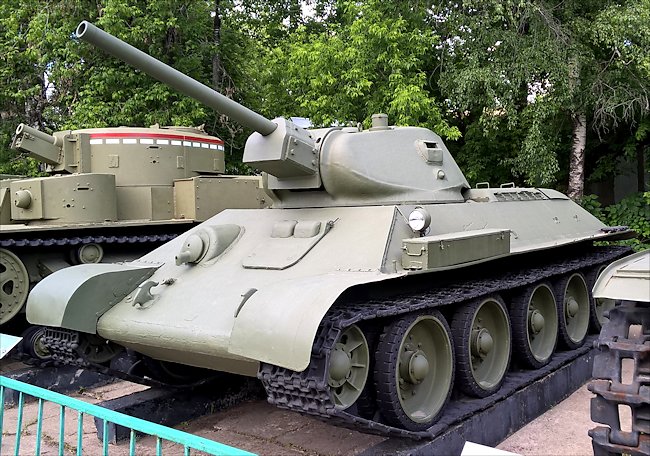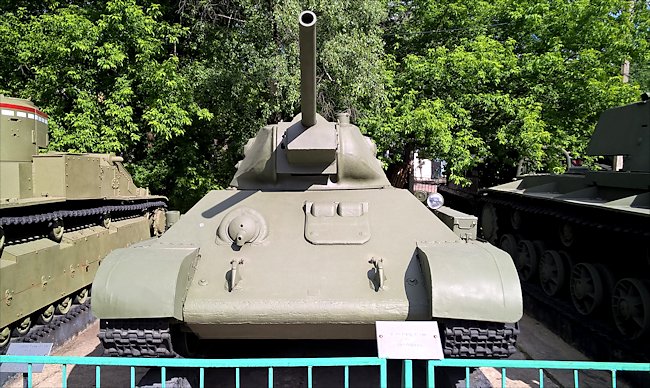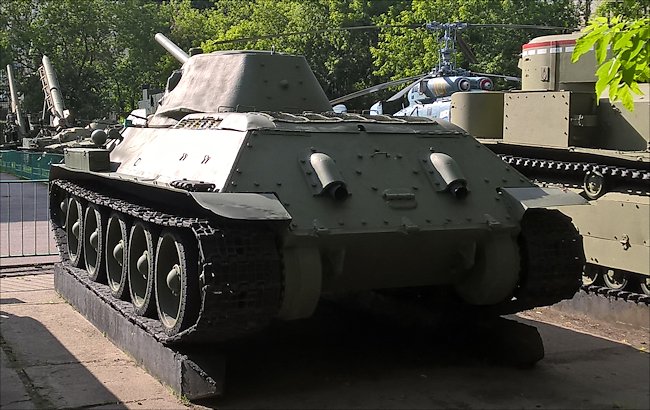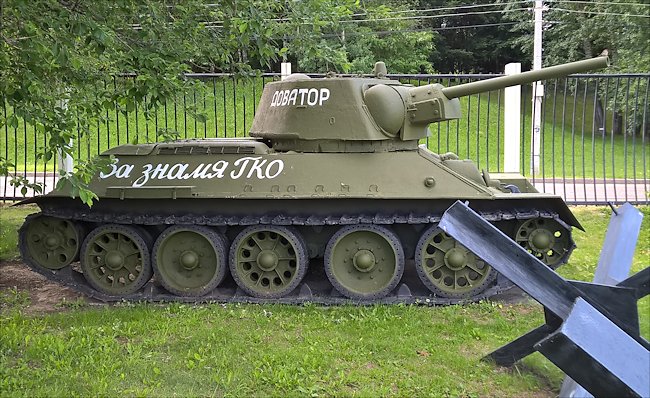The T-34/76 Tanks in Moscow
There are two T-34/76 Soviet WW2 Medium Tank you can visit in Moscow. One is at the Central Armed Forces Museum and the other at the Central Museum of the Great Patriotic War 1941 - 1945, Park Pobedy. Outside of Moscow there is a third at the Tank Museum in Kubinka.

Soviet WW2 T-34/76 m1941 Medium Tank at the Central Armed Forces Museum in Moscow
In 1941 the Soviet tactics or sending wave upon wave of massed tanks unsettled the invading Germans. They were surprised at how effective the new Soviet KV-I heavy and T-34/76 medium tanks. They had difficulty knocking them out and found their tanks armour lacking in protection.
German 4th Panzer's losses on the Eastern Front of ten tanks, two 88 mm guns, one 105 mm howitzer, and one 100 mm gun were far from crippling, and had to be set against the destruction of 18 enemy tanks. But the effects of this, the first major encounter with a mass of the latest Russian machines, were far-reaching.

The front sloping armour in the T-34/76 Medium Tank was very effective deflecting German tank shells in 1941
The Germans still frequently demonstrated that they were far ahead of the Russians in training, technique and execution of imaginative ideas. Yet in tank technology the Germans were far behind in firepower, protection and mobility. In 1941 in a tank-versus-tank battle they were out-classed.
To begin with, the check on this front, imposed by a coherent Russian defense, had repercussions elsewhere as German lines of communication began to collapse in alternating conditions of blizzard and frost, thaw and glutinous mud. Stop-go killed off the German momentum and presented the Russians with invaluable time and opportunities to assemble fresh forces to create new stop lines protecting the obvious enemy objective, Moscow.

Soviet T-34/76 tanks had smoke dispensers at the rear of their tank
Within a matter of months, Panzer III and IV tanks were to have their armor thickness doubled by the addition of face-hardened, spaced plates; and their guns improved, respectively by the L60 50mm and a very good 'long', L43 75 mm piece with a muzzle velocity of 700 m/sec (2300 ft/sec).
Simultaneously, pre-war design projects would be up-dated to put into production a 56-ton tank, armed with an 88 mm gun, the Tiger I, and a medium tank of 43 tons with sloped armor and an L 70, 75 mm gun, the Panther D.

Red Army Soviet WW2 T-34/76 m1942 Medium Tank at the Museum of the Great Patriotic War 1941 - 1945, Park Pobedy in Moscow. Produced at Factory No.183. Notice the upgraded turret.
Tracks would be made much wider to help match the superior cross-country performance of the wide-tracked KV-I and T-34/76 tanks. None of these improvements, however, were ready in time to save the Germans from the bitter winter ahead.
German narrow tank tracks of too high a ground pressure sank in the mud and, frequently, were then frozen in solidly before the vehicles could be dragged out. German vehicles were not prepared for the bitter Russian winter temperatures unlike the Red Army tanks. German fuel and lubricants in such low temperatures froze, as did engine coolants of insufficient density.
For the first time in Russia, as the Germans began to withdraw, large numbers of their machines had to be abandoned. Wholesale breakdowns and a widespread spares famine now broke the German maintenance and repair organization. In order to keep just a few tanks running, indiscriminate cannibalization was inflicted on tanks which might otherwise have been recovered and returned to action
Those which were sent back to the fatherland by rail for overhaul usually arrived at their destination stripped of nearly everything movable and in need of a rebuild.
Where can I find surviving T-34/76 Tanks?
- T-34/76 m1940 - Great Patriotic War museum, Minsk, Belarus
- T-34/76 m1940 - 4x Museum of military equipment 'Battle Glory of the Urals', Verkhnyaya Pyshma, Sverdlovsk Oblast, Russia
- T-34/76 m1941 - Musee des Blindes, Saumur, France
- T-34/76 m1941 - Finnish Armour Museum, Parola, Finland
- T-34/76 m1941 - Savon Prikaati garrison, Mikkeli, Finland
- T-34/76 m1941 - Pohjois-Karjalan Prikaati's garrison area, Kontioranta, Joensuu, Finland
- T-34/76 m1941 - Polish Army Museum, Warsaw, Poland
- T-34/76 m1941 - Zwyciestwa street, Gdansk, Poland
- T-34/76 m1941 - Muzeum Oreza Polskiego w Kolobrzegu, Kolobrzeg, Poland
- T-34/76 m1941 - Bragin, Homiel Oblast, Belarus
- T-34/76 m1941 - New Petrovtsy, Kiev Oblast, Ukraine
- T-34/76 m1941 - Glukhov, Sumy Oblast, Ukraine
- T-34/76 m1941 - Bondarevka, Luhansk Oblas, Ukraine
- T-34/76 m1941 - Museum of the Great Patriotic War 1941 - 1945, Park Pobedy, Moscow, Russia
- T-34/76 m1941 - Central Armed Forces Museum, Moscow, Russia
- T-34/76 m1941 - Kubinka Tank Museum, Russia
- T-34/76 m1941 - Alakurtti, Murmansk Oblast, Russia
- T-34/76 m1941 - Shlisselburg, Leningrad Oblast, Russia
- T-34/76 m1941 – 2x National Automobile Museum, Vsevolozhsk Leningrad Oblast, Russia
- T-34/76 m1941 - Medyn, Kaluga Oblast, Russia
- T-34/76 m1941 - 2x Vadim Zadorozhny Museum, Arhangelskoe, Moscow Oblast, Russia
- T-34/76 m1941 - Sergey Chibineev Collection, Pushkino, Moscow Oblast, Russia
- T-34/76 m1941 - Private collection, Moscow area, Russia
- T-34/76 m1941 - Naro-Fominsk, Moscow Oblast, Russia
- T-34/76 m1941 - Tambov, Tambov Oblast, Russia
- T-34/76 m1941 - Panoramic Museum Stalingrad Battle, Volgograd Volgograd Oblast, Russia
- T-34/76 m1941 - Taman peninsula, Krasnodar Krai, Russia
- T-34/76 m1941 - National Armor and Cavalry Museum, Fort Benning, GA, USA
- T-34/76 m1941 - Fort Lee U.S. Army Ordnance Museum, VA, USA
- T-34/76 m1941 flamethrower – National Automobile Museum, Vsevolozhsk Leningrad Oblast, Russia
- T-34/76 m1942 - Finnish Armour Museum, Parola, Finland
- T-34/76 m1942 - 2x Polish Army Museum, Fort IX Czerniakowski, Warsaw, Poland
- T-34/76 m1942 - Lubuskie Military Museum, Drzonow, Poland
- T-34/76 m1942 - Citadel museum, Poznan, Poland
- T-34/76 m1942 - Army Technical Museum, Lesany, Czech Republic
- T-34/76 m1942 - Military Barracks, Banja Luka, Bosnia and Herzegovina
- T-34/76 m1942 - Korsun-Shevchenkivskyi, Cherkasy Oblast, Ukraine
- T-34/76 m1942 - Zvenyhorodka, Cherkasy Oblast, Ukraine
- T-34/76 m1942 - Donetsk, Donetsk Oblast, Ukraine
- T-34/76 m1942 - Krasnyi Lyman, Donetsk Oblast, Ukraine
- T-34/76 m1942 - Museum of the Great Patriotic War 1941 - 1945, Park Pobedy, Moscow, Russia
- T-34/76 m1942 - T-34 History Museum, Sholohovo, near Moscow, Russia
- T-34/76 m1942 - 2x Kubinka Tank Museum ,Russia
- T-34/76 m1942 - Novosokolniki, Pskov Oblast, Russia
- T-34/76 m1942 - Stalin Line Museum, Holmatka, Pskov Oblast, Russia
- T-34/76 m1942 - Velikiye Luki area, Pskov Oblast, Russia
- T-34/76 m1942 - 63th BTRZ (tank repair plant), St. Peterburg, Leningrad Oblast, Russia
- T-34/76 m1942 - Belyj, Tver Oblast, Russia
- T-34/76 m1942 - Khvastovichi, Kaluga Oblast, Russia
- T-34/76 m1942 - Schucshye, Voronezh Oblast, Russia
- T-34/76 m1942 - Sevastopol, Crimean Peninsula, Russia
- T-34/76 m1942 - Mamayev Kurgan Memorial (Northwestern slope) Volgograd (formerly Stalingrad), Volgograd Oblast, Russia
- T-34/76 m1942 - Volgograd Shipyard, Volgograd, Volgograd Oblast, Russia
- T-34/76 m1942 - Volgograd Tractor Factory, Volgograd, Volgograd Oblast, Russia
- T-34/76 m1942 - Local museum, Salekhard, Yamalo-Nenets Okrug, Russia
- T-34/76 m1942 - Museum of Soviet Military Equipment Vladivostok, Primorsky Krai, Russia
- T-34/76 m1942 - The Collings Foundation, Stow, MA, USA
- T-34/76 m1943 - German Tank Museum, Munster, Germany
- T-34/76 m1943 - 2x Soviet Memorial, Berlin-Tiergarten, Germany
- T-34/76 m1943 - Finnish Armour Museum, Parola, Finland
- T-34/76 m1943 - Local museum, Gorodenko, Estonia
- T-34/76 m1943 - Armoured Weapons Museum, Land Forces Training Centre, Poznan, Poland
- T-34/76 m1943 - Studzianki Pancerne, Poland
- T-34/76 m1943 - Army Technical Museum, Lesany, Czech Republic
- T-34/76 m1943 - 2x Stalin Line Museum, Zaslavl, Minsk Voblast, Belarus
- T-34/76 m1943 - Rechytsa, Homiel Voblast, Belarus
- T-34/76 m1943 - Chernivtsi, Chernivtsi Oblast, Ukraine
- T-34/76 m1943 - Khmelnytskyi, Khmelnytskyi Oblast, Ukraine
- T-34/76 m1943 - Kamenets-Podolski, Khmelnitsky Oblast, Ukraine
- T-34/76 m1943 - Chopovichi, Zhitomir Oblast, Ukraine
- T-34/76 m1943 - New Petrovtsy, Kiev Oblast, Ukraine
- T-34/76 m1943 - Cherkasy Oblast, Ukraine
- T-34/76 m1943 - Olexandria, Kirovohrad Oblast, Ukraine
- T-34/76 m1943 - Bolgrad, Odessa Oblast, Ukraine
- T-34/76 m1943 - Gorlovka, Donetsk Oblast, Ukraine
- T-34/76 m1943 - Leuseni, Moldova
- T-34/76 m1943 - T-34 History Museum, Sholohovo, near Moscow, Russia
- T-34/76 m1943 - Sambatuksa, Republic of Karelia, Russia
- T-34/76 m1943 - Karachev, Bryansk Oblast, Russia
- T-34/76 m1943 - Kantemirovka, Voronezh Oblast, Russia
- T-34/76 m1943 - Krasnodar, Krasnodar Krai, Russia
- T-34/76 m1943 - Perm, Perm Krai, Russia
- T-34/76 m1943 - 2x Korea War Museum, DangDong, China
- T-34/76 m1943 - Nizhny Tagil, Sverdlovsk Oblast, Russia
- T-34 OT-34 flamethrower - Victory Park, Simpheropol, Crimean Peninsula, Russia
- T-34 OT-34 flamethrower - Museum of military equipment Battle Glory of the Urals Verkhnyaya Pyshma, Sverdlovsk Oblast, Russia
- T-34 OT-34 flamethrower - Tank Museum of UVZ (Firma-Museum), Nizhny Tagil Sverdlovsk Oblast, Russia
- T-34/85 hull T-34/76 m1941 turret - Museum of the Great Patriotic War 1941 - 1945, Park Pobedy, Moscow, Russia
- T-34/85 hull T-34/76 m1942 turret - Prokhorovka, Belgorod Oblast, Russia
- T-34/85 hull T-34/76 m1942 turret - Khimki, Moscow Oblast, Russia
- T-34/85 hull T-34/76 m1942 turret - Kamensk-Shahtinsky, Rostov Oblast, Russia
- T-34/85 hull T-34/76 m1943 turret - Museum of the National Military History, Padikovo Moscow Oblast, Russia
- Source - Pierre-Oliver Buan - http://the.shadock.free.fr/Surviving_Panzers.html
ww2 tank books

